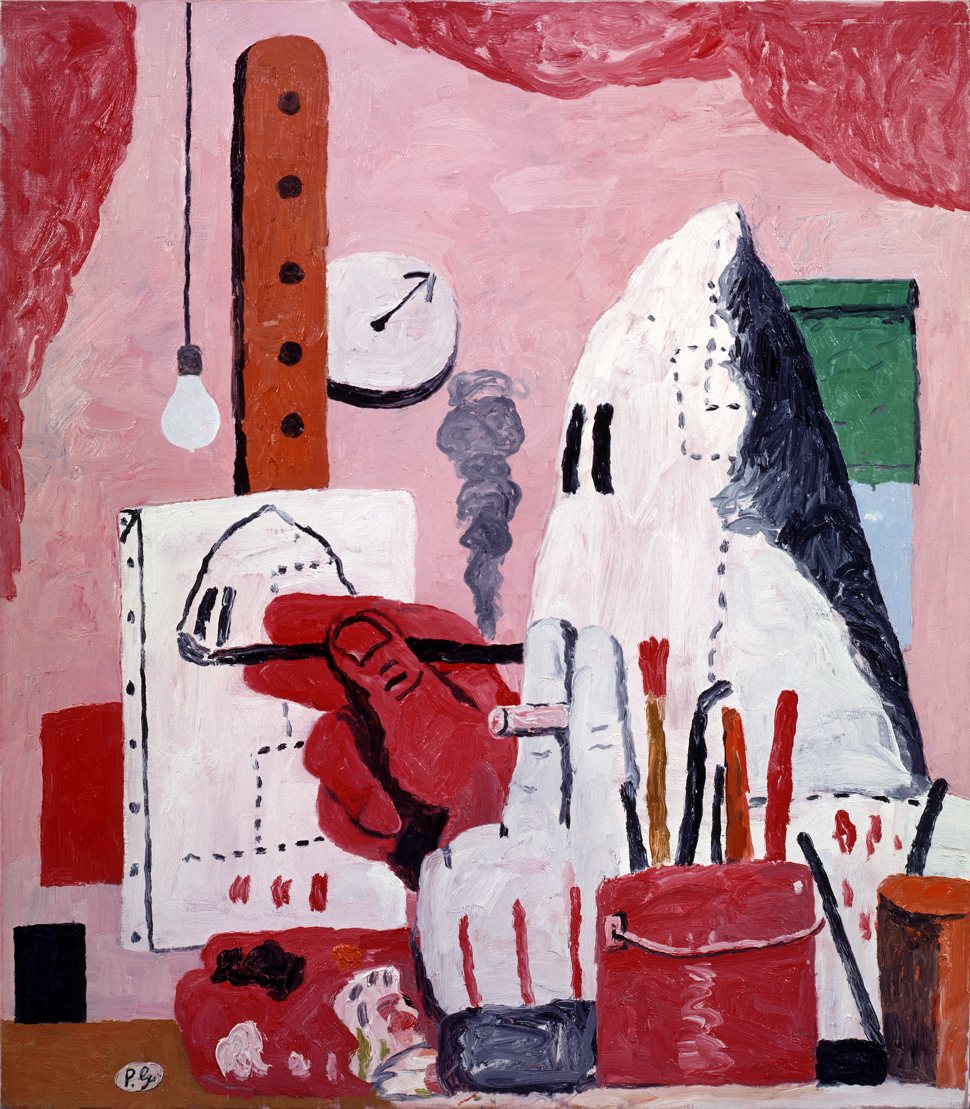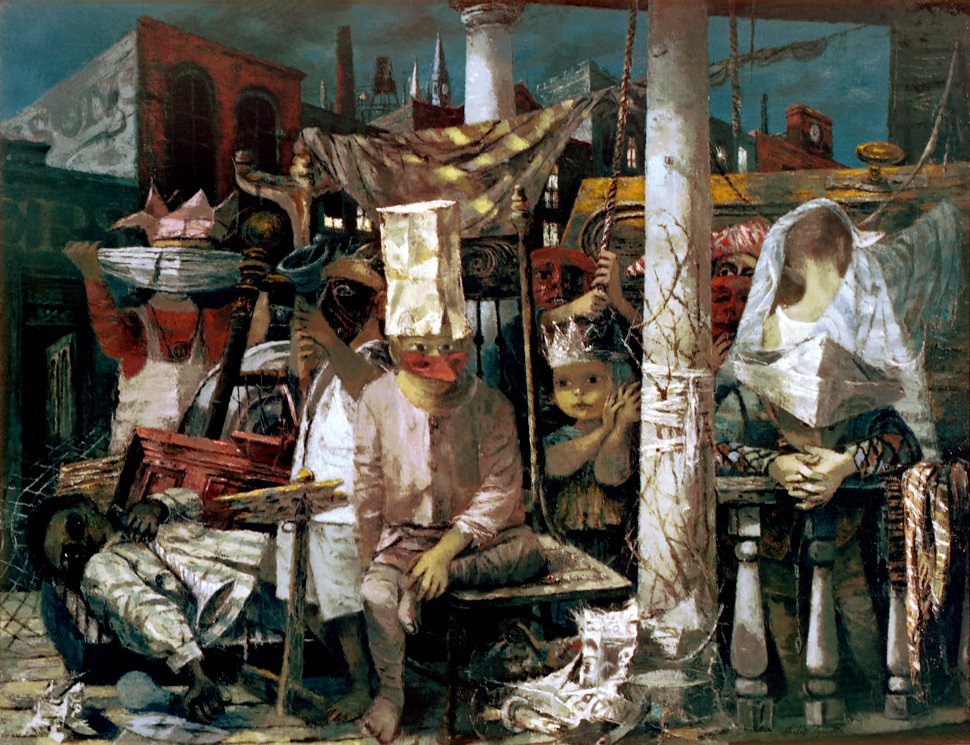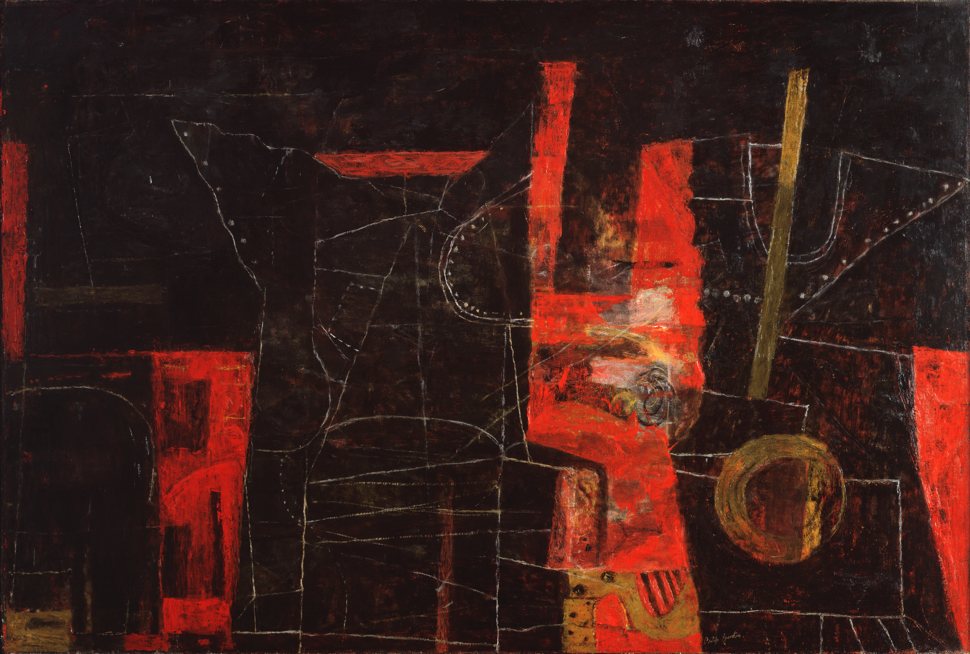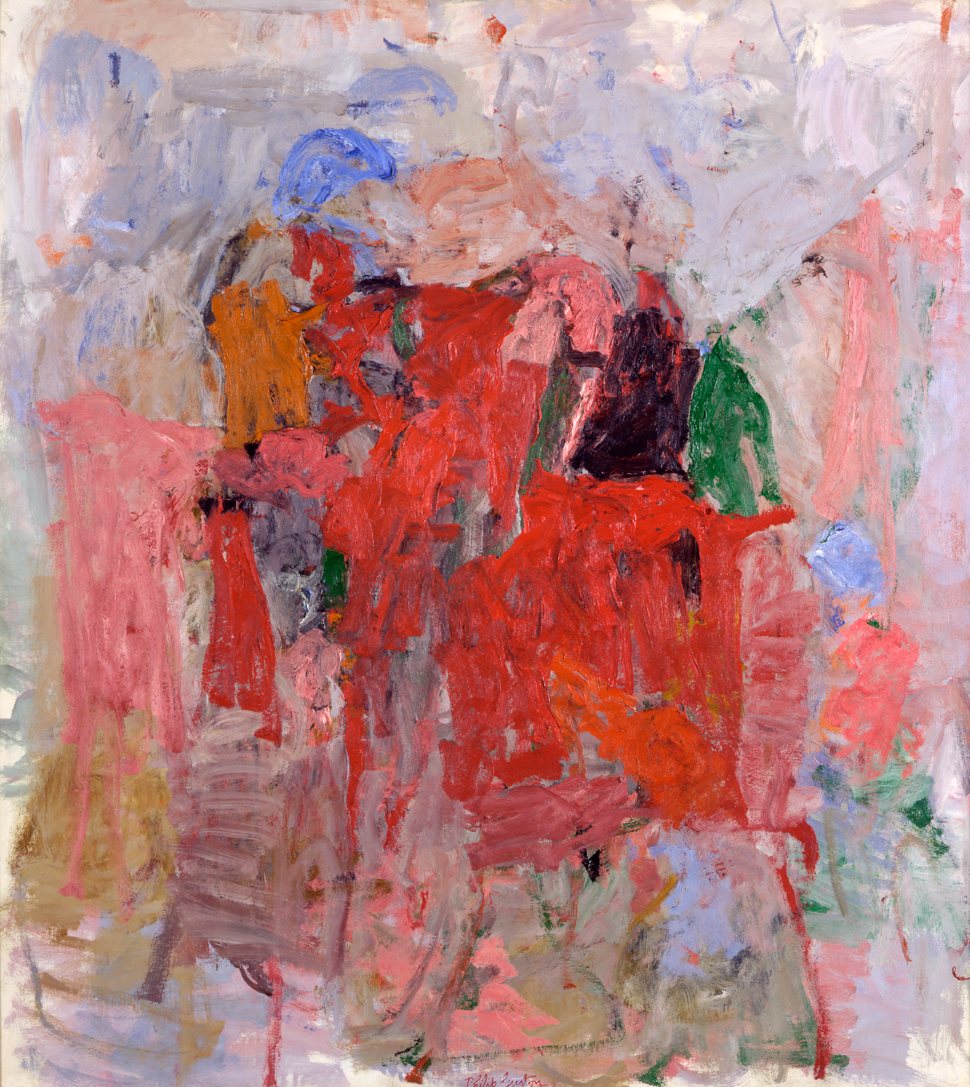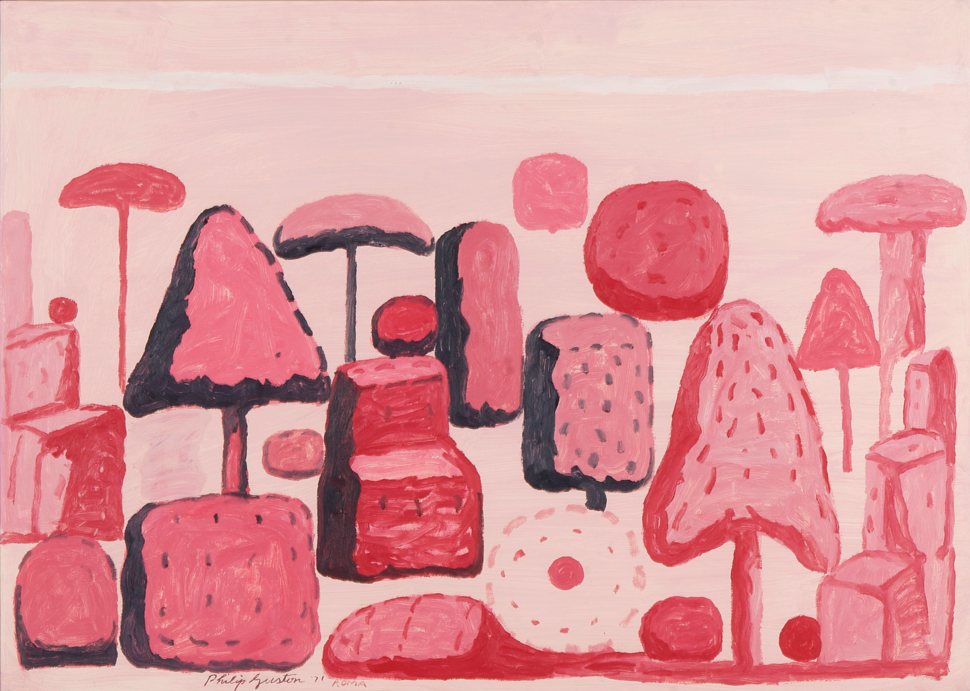Philip Guston is one hundred, or would be if he were with us still. His work very much is, but the artist left long ago. And left prematurely, as did so many of his generational cohort. His high-school classmate Jackson Pollock died young—at forty-four—of creative despair, the bottle, and automotive Russian roulette. Rothko died in late middle age of creative despair, the bottle, and a well-planned suicide by razor. De Kooning lived to a great age—ninety-three—died sober, and performed painterly miracles well into his eighties, although much of his last decade was a blur. Weakened by a heavy reliance on booze and butts—images of which litter the artist’s late self-portraits, along with cholesterol-heavy French fries—Guston died of a heart attack at the same age as Rothko, sixty-seven, yet was still at the height of his powers and on the eve of the unprecedented fame that resulted from his traveling retrospective of 1980-1981.
Nevertheless, for countless painters who came to their vocation around that time or during the thirty-plus years since that show, Guston was embraced as a near contemporary in a way that none of his celebrated coevals have been. The resulting paradox—of being at once an avant-garde Old Master and a perennial beacon for emerging or reemerging talents—points to the essentially anomalous historical status from which Guston both suffered and benefited most of his career. Furthermore, it underscores the richly syncretic or, as hostile critics would have it, eclectic and anachronistic nature of his sensibility.
Guston was never an autobiographical painter per se, nor was he a “history painter” in the traditional sense of that term. Yet his work breathes—and sometimes gasps or wheezes—lived experience, and he crammed more of it into a relatively short span than most of his generation while often seeming to be ahead or behind the pack. But just how ahead of or behind his time was Guston during any given period of his career, just how out of step?
Let’s stop to examine his abruptly truncated formal education. Guston was still in his early teens when his Los Angeles public high school art teacher, the improbably named Frederick John de St. Vrain Schwankovsky, introduced him to mystics P. D. Ouspensky and J. Krishnamurti as well as to modernists Pablo Picasso and Giorgio de Chirico, all of whom were equally exotic to Americans of that era. Following his expulsion from school for coauthoring a satire of the English Department with Pollock, Guston worked at a bookstore and as a film extra, among various odd jobs. Within three years of leaving the classroom for good he had fallen in with the locally influential Magic Realist painter Lorser Feitelson, who brought him to the collection of Walter and Louise Arensberg. There, for the first time, he could study a wide assortment of Cubist, Dada, and Surrealist works firsthand in circumstances to which few enthusiasts of “the new” of any age ever had access.
A year later he was in the thick of Communist Party circles around the John Reed Club. And he became the target of an LAPD Red Squad raid for his contribution to an exhibition devoted to the racially motivated trial of the Scottsboro Boys, for which he painted a picture about lynching that was the first of many of his works to feature ominous images of Ku Klux Klansmen. Shortly thereafter Guston was on his way to Morelia in central Mexico to work on a commission under the patronage of revolutionary muralist David Alfaro Siqueiros—later Pollock’s teacher in New York—and by the end of 1934 he was back in California, where he joined the New Deal-sponsored Public Works of Art Project and realized a mural for the International Ladies Garment Workers Union.
Guston was twenty-one. His was a very fast start, and during the scant decade since he had first taken up drawing, he had in every way covered a lot of ground. It is hard if not impossible to think of a single artist of his circle who underwent a more rapid or far-flung training. In 1937 Guston married painter and later poet Musa McKim. Unpredictably, though marriage may have precipitated his decision, he then abandoned the downtown Manhattan scene and in 1941 moved inland for an extended sojourn in the Midwest, starting in Iowa City, where he taught at the state university until 1945, and then continuing on to St. Louis, where he was a member of the faculty of Washington University until 1947. There he was succeeded by the exiled German painter Max Beckmann, whose work had been a lodestar for Guston since he had initially encountered it at the Buchholz Gallery in New York a decade before.
Advertisement
For Guston, Beckmann was the “man to beat” just as Picasso had been for Pollock and de Kooning, although Guston also learned much from the Spanish master of the largely decimated School of Paris during and just after the German Occupation. Indeed many of Guston’s canvases of the mid- to late- 1940s amount to brilliant variations on Beckmann’s dense allegorical tableaux. Yet they also contain readily identifiable traces of, if not overt references to, other artists as disparate as de Chirico (whose inspiration would return in the 1960s and 1970s as one of the crucial predicates for Guston’s last great body of work) and Yasuo Kuniyoshi, as well as aspects of the Regionalism of Grant Wood. Some of these paintings—notably, If This Be Not I (1945)—resemble a restaging of Italian Metaphysical painting in the American heartland.
Yet in much the same way as Brahms composed variations on themes from Haydn, Handel, Paganini, and Schumann, making their melodies his own by means of elaborate musical embroidery, Guston proved a skilled adapter of diverse sources, motifs, and mannerisms that came together in his hands as compelling, if still formative, works. Those works earned him public recognition that no one close to him had yet enjoyed, including a feature article in Life magazine and a fellowship to the American Academy in Rome, where he fortuitously made de Chirico’s acquaintance. By the standards of the time in the United States, his was that rarest of things: a modern-art success story.
It is the measure of Guston’s large, complex, and still emerging artistic ambition that he did not settle for those rewards and the comfortable life as an academic painter they more or less guaranteed. Thus the years 1947 to 1950 saw a painfully gradual unmaking of the relatively tradition-bound aesthetic that had garnered him such acclaim, followed by the equally slow and arduous forging of a radically new approach. It can be traced formally in the trio of canvases that were the focus of this pivotal three-year interval, The Tormentors (1947-1948), Review (1949-1950), and Red Painting (1950). From the first to the last, one witnesses the gathering in, amalgamation, and ultimate dissolution of the costumed characters, props, and decors that previously filled his theater of enigmas. Each in its own way, these works commemorate the politics and poetics of his youth while anticipating, in their increasing degree of abstraction, the break-out nonfigurative—or barely figurative—paintings that realigned him with his Abstract Expressionist friends Pollock, de Kooning, Rothko, and Brooks, as well as Franz Kline, Clyfford Still, Bradley Walker Tomlin, Adolph Gottlieb, Robert Motherwell, and others.
Arguably, it had taken Guston longer to “get there,” but he brought all the more with him in the way of exposure to the alternatives to and tributaries of “mainstream” modernism. Guston’s own attraction to and struggles with philosophical systems—Marxist, Existentialist, and Formalist—constitute the agon at the heart of the paintings and drawings he made as an Abstract Expressionist. But as he proceeded, the example of John Cage, with his sage, smiling disregard for logical absolutes, unlocked the way for Guston by obviating contradictions and easing the burdens of dialectical thinking without entirely removing its structure and satisfactions.
This is reflected-though not illustrated-by the basic syntax of his earliest fully abstract paintings, starting with White Painting (1950). Built up of clusters and layers of short, tactilely rich, and varied strokes applied to the canvas at close range such that the artist could not readily assess their cumulative effect until he stepped back after an extended work session, these first true masterpieces by Guston translate the rigid, spare, fragmented grids of Piet Mondrian’s “plus/minus” paintings into the still-developing gestural idiom of the New York School. The results were a scintillating weave of marks that suggest landscapes—causing Guston to be misnamed an Abstract Impressionist while more generally evoking a world of constant mutation and flux, contingency and metamorphosis, simultaneous doing and undoing, becoming, being, and unbecoming. In short, a world where existentialist angst and struggle exchanged their polar charges with Zen equanimity and acceptance.
In the mid-1950s Guston’s atmospheric canvases grew increasingly congested, and his amorphous imagery assumed greater weight and definition, as if the figments of his imagination found in The Tormentors, Review, and Red Painting were reasserting themselves, as was, essentially, the case. With this shift, the predominately gray/pink/red palette of works such as Attar (1953), Zone (1953-1954), and Painting (1954)—the final work being the first of Guston’s to enter MoMA’s collection, as a gift of no less a talent spotter than Philip Johnson—gave way to a wider spectrum of greens, blues, and oranges in addition to Guston’s favorite roseate tints and grisaille tones. At the same time, the cryptic titles of the previous half-decade yielded to more revealingly allusive if not forthrightly declarative ones: Clock (1956-1957)—MoMA’s second Guston, Mirror (1957), To Fellini (1958), and Painter (1959). The questions posed by these pictures had ceased to be on the order of the lyrically metaphysical as in If This Not Be I? but instead were, in the words of art historian and supreme pictorial exegete Leo Steinberg, physically, gropingly tangible ones of “whereness” and “whatness.”
Advertisement
The second major turning point in Guston’s career, the first being toward abstraction, was the fitful move away from it that occurred between 1966 and 1968. During that interlude, Guston’s work—most of it drawings rather than paintings—oscillated between cryptic minimal compositions often consisting of a single shape, stroke, or pattern and simple, bold cartoonish evocations of people and things. The seeming about-face in Guston’s work that was announced by his first, and only, exhibition at the powerful Marlborough Gallery—representing many other Abstract Expressionists or their estates—resulted from the acute discrepancy he felt existed between the transcendental qualities of his abstract work and the harsh, down-to-earth realities of America in crisis, and his need to confront that strife head on.
As it happened, the heads that filled the tragicomic scenes depicted in Guston’s post-1968 work were stubbly, cigarette-smoking, Popeye-like self-portraits mixed with hooded Ku Klux Klansmen (frequently self-portraits also) lifted out of his political paintings of the 1930s and assigned roles equivalent to those of Babel’s marauding Cossacks. When these tableaux were first presented to close friends—chief among them the Cage-related composer Morton Feldman, who had been closer to Guston personally than Cage himself—there was genuine consternation. Gone was the luminosity of his early abstractions as well as the lushness of his middle-period ones, and gone too was the enigmatic ambiguity of the late ones. In their place were unmistakable images of unsettling disorder, both in the artist’s intimate studio sanctuary and in the raw, rubble-strewn wastelands that metaphorically surrounded it.
When this altogether unexpected body of work was first shown at the Marlborough Gallery in 1970, there was a general uproar of the sort that rarely attends the exhibition of an established master’s current production and a backlash epitomized by New York Times critic Hilton Kramer’s bellwether but notoriously wrong-headed attack headlined “A Mandarin Pretending to be a Stumblebum.” America was coming apart at the seams, and rather than providing solace, Guston’s pictures added visual cacophony and psychic dissonance. As things turned out, much of the art world, including many others formerly close to the artist, recoiled as well, prompting Guston to retreat to Woodstock and to leave Marlborough.
Shortly thereafter, as the scandal surrounding Marlborough’s mishandling of the Rothko estate was breaking, David McKee, with whom Guston had worked while at the gallery, also left to set up shop on his own, on the mezzanine of the Barbizon Hotel for Women at 140 East Sixty-Third Street. In that unlikely location, tellingly at a distance from the “mainstream” dealers’ main drag at the junction of Fifth Avenue and Fifty-Seventh Street, McKee offered Guston an opportunity to exhibit regularly. Those who grasped the significance of Guston’s challenge to established “high modernist” taste beat a path to that tall, light space to immerse themselves in the same strange, “prematurely postmodern” vision of contemporary life that Guston devoted the remaining decade of his life to portraying in a sometimes sludgy, more often tumultuous tidal wave of images that were at once hilarious and horrifying.
In the paintings and drawings he made while in residence at the American Academy in 1970 and 1971, one readily recognizes the spatial dynamics of Guston’s entire oeuvre, the latent or overtly stated matrix of vertical and horizontal lines that derive from the structure of Renaissance perspective that was subsequently collapsed by Cubism and flattened by Mondrian. They are visible in the swelling brick walls, boxy window frames, and lumpy books and canvases that fill the pictorial horizon while mapping out the picture plane in quasi-proportional units. Whereas similarly gridded patches or modules in Guston’s early abstractions were brittle and optically elusive, in the later figurative works they are bulky, soft, and instantly tangible. (In this respect they recall Claes Oldenburg’s sculptures of the 1960s, likewise evoking the “elephantine sadness” that Lucy Lippard ascribed to Oldenburg’s hapless caprices.) Indeed, the pinks and reds frequently deployed in Guston’s forms render them positively fleshy and as forlorn as they are droll.
But what of those forms themselves? Their fundamental geometry is rudimentary in the extreme. Basically all the Roman pictures—like the majority of Guston’s late works—are composed of lateral arrays, impacted layers, or dense cairn-like piles of circles, squares, and triangles. Are they caricatures of Platonic solids in keeping with Renaissance Italian precedent? That may ring true in retrospect, but I suspect their origin lies elsewhere. Specifically, I am reminded of a famous drawing by the Zen monk Sengai Gibon (1750-1837) that represents the universe as a chain of three overlapping shapes: a square, a triangle, and a circle. In Guston’s images these shapes masquerade as pines, hedges, topiary trees, hooded heads, bare bald heads, boulders, hewn stones, tablets, clocks, wheels, and so on in a ceaseless metamorphic series emanating from each of these primary iconographic emblems.
Together, they constitute the DNA of Guston’s art, the code that engendered its myriad mutations yet guaranteed its formal as well as symbolic integrity. In these three shapes East meets West, Sengai’s magisterial reductionism meets Leon Battista Alberti’s mastery of complexity, Cage and Feldman meet de Chirico and Picasso, and the universe in all its transformational potential became accessible to a brooding yet playful artist whose ambition was to hold together contradictions that overwhelmed or frightened away so many of his peers while claiming for himself an unlimited license to make old things new. Although cut off in the midst of his most fecund period, Guston nonetheless succeeded in putting all the essential pieces of that enormous project in place and in motion. Moreover, unlike the legendary sixteenth-century Rabbi Low of Prague, who conjured up the first golem, Guston never erased the sign that gave his creations life, so that to this day they quiver and will forever continue to quiver with a raucous, soulful, and altogether uncanny vitality.
Adapted from Robert Storr’s preface to Go Figure! New Perspectives on Guston, edited by Peter Benson Miller, which will be published by New York Review Books and the American Academy in Rome on March 10.


